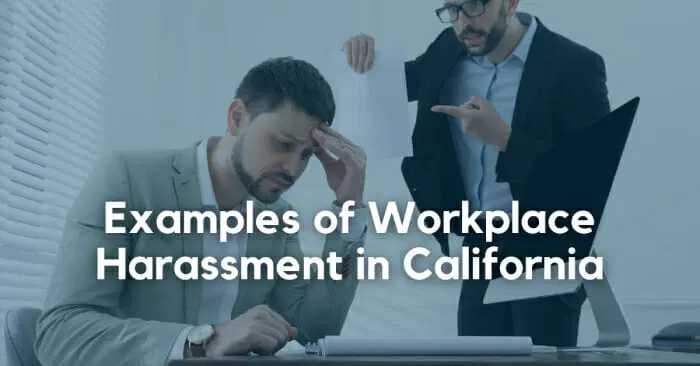
Guide to Workplace Harassment in California with 25 Examples
Legally reviewed by: Jessica Anvar Stotz, JD, MBA
What is considered harassment in the workplace in California?
Short answer: In 2024, workplace harassment in California is defined as unwelcome conduct based on protected characteristics such as race, age, gender, or religion that creates a hostile or offensive work environment.
Under California law, workplace harassment is defined as unwelcome conduct in the workplace, based on a protected characteristic, such as sex, race, age, disability, or sexual orientation, that is severe or pervasive enough to create a hostile or abusive work environment, or that results in an adverse employment decision, such as termination, demotion, or denial of promotion.
In order for behavior to be considered workplace harassment under California law, it must be both unwelcome and objectively offensive. This means that the behavior is offensive to a reasonable person in the same circumstances, and not simply a matter of personal preference or taste.
California Workplace Harassment Overview
| Factors | Description |
| Unwanted Advances | Inappropriate romantic or sexual propositions |
| Offensive Comments | Insulting, derogatory, or explicit language |
| Display of Explicit Material | Inappropriate images, videos, or objects at work |
| Cyberbullying | Harassment through emails, social media, etc. |
| Hostile Comments | Hurtful or intimidating remarks |
| Verbal Abuse | Shouting, belittling, or name-calling |
| Physical Intimidation | Threats or gestures that invoke fear |
| Invasion of Personal Space | Unwanted touching or invading personal boundaries |
| Isolation or Exclusion | Purposefully leaving someone out of activities |
| Persistent Unwanted Attention | Continuously targeting an individual for attention |
| Gender or Racial Discrimination | Harassment based on protected traits |
Workplace Harassment Evaluator Quiz
Looking to see if you might have a valid workplace harassment case? Take our short online quiz to get an answer in 90 seconds or less.
Examples of California Workplace Harassment
Examples of workplace harassment can include verbal or physical conduct, such as sexual advances, racial slurs, or physical intimidation, as well as nonverbal conduct, such as displaying offensive materials or making threatening gestures. Below is an ongoing list of examples of workplace harassment under California law.
- Making derogatory comments or jokes about an employee’s race, gender, sexual orientation, religion, national origin, age, disability, or other protected characteristic.
- Engaging in unwelcome physical contact, such as touching, hugging, or kissing, without consent.
- Making unwanted sexual advances, propositions, or requests for sexual favors.
- Displaying sexually suggestive or explicit images or materials, including on a computer or mobile device.
- Using racially charged or derogatory slurs or epithets.
- Making offensive comments or gestures about an employee’s physical appearance or personal characteristics.
- Intimidating or bullying an employee through verbal or physical means.
- Making threats or using coercion to force an employee to comply with demands or engage in certain behaviors.
- Spreading rumors or gossip about an employee, particularly regarding their sexual or romantic relationships.
- Creating a hostile work environment through persistent or severe harassment, even if the harassment is not directed at a specific individual.
- Sabotaging an employee’s work or reputation through malicious gossip or false accusations.
- Excluding or ostracizing an employee from social or professional events.
- Making derogatory comments or taking adverse action against an employee who complains about harassment.
- Retaliating against an employee who refuses to engage in harassing behavior or reports harassment.
- Creating a hostile work environment based on an employee’s marital status, pregnancy, or caregiving responsibilities.
- Harassing an employee through text messages, emails, or social media platforms.
- Harassing an employee during job interviews or employment screening processes.
- Using racial or ethnic stereotypes to denigrate or humiliate an employee.
- Refusing to provide reasonable accommodations for an employee’s disability or religious practices.
- Subjecting an employee to unwanted or unnecessary scrutiny, such as monitoring their computer or phone usage.
- Failing to take prompt and appropriate action to address harassment complaints.
- Requiring an employee to engage in sexual activity as a condition of employment or advancement.
- Denying an employee a promotion or other employment opportunity based on their protected characteristics.
- Making derogatory comments about an employee’s sexual orientation or gender identity.
- Engaging in quid pro quo harassment, where an employee is offered or denied employment benefits in exchange for sexual favors or other inappropriate conduct.
It’s important to note that this is not an exhaustive list, and there may be other behaviors that qualify as sexual harassment under California law.

How to Know When You Might Have a Case
When Someone Might Have a Case for Workplace Harassment
- Persistent Behavior: If the harassment is ongoing and repetitive, creating a hostile work environment.
- Based on Protected Characteristics: If the harassment is based on protected characteristics such as race, gender, religion, disability, or sexual orientation.
- Impact on Work: If the harassment affects the victim’s ability to perform their job or creates a hostile or intimidating work environment.
- Reported to Employer: If the victim has reported the harassment to their employer or HR department, and the employer has failed to take appropriate action to stop it.
When Someone Might Not Have a Case for Workplace Harassment
- Isolated Incidents: If the behavior is isolated or sporadic rather than persistent.
- Not Based on Protected Characteristics: If the harassment is not based on protected characteristics but rather on personal animosity or general workplace conflict.
- No Impact on Work: If the behavior, while unpleasant, does not substantially affect the victim’s ability to perform their job or create a hostile work environment.
- Not Reported: If the victim has not reported the harassment to their employer or HR department, making it difficult for the employer to address the issue.
Main Workplace Harassment Laws in California
- California Fair Employment and Housing Act (FEHA): This state law prohibits workplace harassment based on protected characteristics, such as race, color, religion, sex, gender, sexual orientation, marital status, pregnancy, and more.
- Title VII of the Civil Rights Act of 1964: While not specific to California, Title VII is a federal law that also prohibits workplace harassment based on protected characteristics and applies to employers with 15 or more employees.
- California Government Code Section 12940: Part of FEHA, this section specifically addresses harassment in employment, defining the forms of harassment and outlining employer responsibilities to prevent and address it.
- AB 1825 and AB 2053: These California laws require employers with 50 or more employees to provide sexual harassment prevention training to supervisors and non-supervisory employees, respectively.
- SB 1300: This law expands California’s anti-harassment protections, making it easier for employees to prove harassment claims and limiting certain employer defenses in harassment cases.
- SB 1343: This law expands mandatory sexual harassment prevention training requirements to employers with five or more employees and includes specific training content for different employee categories.
- California Code of Regulations (CCR), Title 2, Section 11014: This regulation further clarifies the types of harassment covered under FEHA and provides guidelines for compliance.
These laws collectively aim to protect employees from workplace harassment in California. Employers are required to comply with them to ensure a safe and respectful work environment.
Up and Coming Laws
On June 28, 2023, the California State Assembly Committee on Labor and Employment conducted a hearing regarding Senate Bill (SB) 553. If approved as written, SB 553 would institute workplace violence prevention regulations that would apply to nearly all employers across California.
Example Scenarios of Workplace Harassment
Scenario #1
Person A and Person B work together in the same department of a company. Person A is in a managerial position, while Person B is a subordinate. Over time, Person A starts exhibiting inappropriate behavior towards Person B. This behavior includes making unwanted sexual advances, propositions, and requests for sexual favors.
For instance, during team meetings, Person A frequently comments on Person B’s physical appearance, making lewd remarks about their clothing or body. Person A also sends explicit messages to Person B on work-related communication channels, suggesting that they engage in sexual activities outside of work. Furthermore, Person A continuously insists on going out for dinner or drinks alone with Person B, making it clear that they have romantic intentions.
Person B feels extremely uncomfortable with Person A’s behavior and finds it increasingly difficult to focus on work. They experience anxiety, stress, and a loss of motivation due to the persistent harassment. Despite the discomfort, Person B initially hesitates to report the issue due to fear of retaliation or negative consequences for their career.
However, recognizing the seriousness of the situation, Person B eventually decides to document the incidents, including dates, times, and details of each inappropriate encounter. They then report the harassment to the human resources department, providing the evidence they have collected. The company launches an investigation into the matter to ensure a fair and thorough assessment.
Upon investigation, it is determined that Person A’s behavior indeed violated the company’s policies on harassment and created an intimidating, hostile, and offensive work environment for Person B. As a result, disciplinary actions are taken against Person A, which may include reprimands, mandatory training, suspension, or even termination, depending on the severity of the offense and the company’s policies.
In this example, Person A’s persistent and unwelcome sexual advances, propositions, and requests for sexual favors created an environment of harassment for Person B, which ultimately led to their decision to report the behavior and seek resolution through appropriate channels. It’s important to remember that workplace harassment is a serious issue, and everyone has the right to a safe and respectful work environment.
Scenario #2
Person A and Person B are colleagues working in the same department of a company. Person A holds a higher position, while Person B is an employee. Over time, Person A starts engaging in racial harassment towards Person B.
Person A frequently makes derogatory comments about Person B’s race, using racial slurs or offensive stereotypes. They mock Person B’s cultural practices and belittle their achievements based on racial biases. Person A also consistently assigns Person B menial tasks or undesirable assignments, solely based on their race, while giving preferential treatment to other colleagues.
Additionally, Person A deliberately excludes Person B from team meetings, social events, or important discussions, simply because of their race. They undermine Person B’s contributions, dismiss their ideas, and often interrupt or talk over them during conversations. This consistent pattern of racial harassment has a severe impact on Person B’s confidence, emotional well-being, and job satisfaction.
Person B, feeling distressed and marginalized, decides to address the issue and seek resolution. They start documenting the instances of racial harassment, noting down dates, times, and specific details of each incident. Person B then brings this matter to the attention of their supervisor or the human resources department, providing the documented evidence.
Upon receiving the complaint, the company initiates an investigation into the racial harassment allegations. They conduct interviews with both Person A and Person B, as well as any potential witnesses. The company takes this matter seriously and ensures confidentiality and a fair assessment of the situation.
Following the investigation, it is determined that Person A’s behavior violated the company’s policies on racial harassment. The company takes appropriate disciplinary actions, which may include counseling, mandatory sensitivity training, suspension, or even termination, depending on the severity of the offense and the company’s policies.
In this example, Person A’s racially discriminatory behavior created an environment with workplace harassment for Person B, negatively impacting their well-being and job satisfaction. It emphasizes the importance of addressing racial harassment in the workplace and taking necessary actions to ensure a respectful and inclusive environment for all employees.
Scenario #3
Person A and Person B work together in a professional setting. Person A is a supervisor, while Person B is an employee. Over time, Person A starts engaging in harassment towards Person B based on their LGBTQ identity.
Person A frequently makes derogatory comments about Person B’s sexual orientation, using slurs, stereotypes, or offensive jokes. They openly express homophobic views, mock LGBTQ individuals, or question the validity of their relationships. Person A may also spread rumors or gossip about Person B’s personal life, specifically targeting their LGBTQ identity.
In addition to verbal harassment, Person A may intentionally exclude Person B from professional opportunities or social events based on their sexual orientation. They may assign them menial tasks, deny them access to important information, or undermine their contributions solely because of their LGBTQ identity. This persistent pattern of discrimination and harassment deeply affects Person B’s well-being, job satisfaction, and professional growth.
Feeling distressed and marginalized, Person B decides to address the issue and seek resolution. They start documenting instances of harassment, recording dates, times, and specific details of each incident. Person B then reports the harassment to their supervisor, the human resources department, or follows the appropriate reporting procedures within the organization.
The company responds to the complaint by launching an investigation into the allegations of harassment. They conduct interviews with Person A, Person B, and any potential witnesses, ensuring a fair and thorough assessment of the situation. The company upholds a commitment to maintaining a safe and inclusive work environment.
Upon completion of the investigation, it is determined that Person A’s behavior violated the company’s policies against discrimination based on sexual orientation. The company takes appropriate disciplinary actions, which may include counseling, mandatory diversity and inclusion training, suspension, or even termination, depending on the severity of the offense and the company’s policies.
In this example, Person A’s harassment based on Person B’s LGBTQ sexual orientation created a hostile work environment, negatively impacting their well-being and professional growth. It highlights the significance of combating LGBTQ discrimination in the workplace and ensuring equal treatment and respect for all employees, regardless of their sexual orientation.
When Should I File a Workplace Harassment Claim in California?
If you believe that you have been subjected to workplace harassment, it’s important to take action promptly. Here are some steps you can take:
- Report the harassment to your employer: In California, employers are required to have a policy for preventing and addressing workplace harassment, and you should follow the procedures set out in that policy. You should report the harassment to your supervisor, HR representative, or other designated person, in writing if possible, and keep a copy for your records.
- Keep a record of the harassment: It’s important to document any incidents of harassment, including dates, times, locations, and details of what was said or done. You should also keep any emails, text messages, or other communications that relate to the harassment.
- Seek support: Workplace harassment can be very stressful and can have a significant impact on your well-being. You should consider speaking to a trusted friend, family member, or therapist for emotional support.
- Consult with an attorney: If you believe that your employer has not taken appropriate action to address the harassment, or if you have suffered adverse employment actions as a result of reporting the harassment, you may want to consult with an attorney who specializes in employment law. They can help you understand your legal rights and options for pursuing a claim.
It’s important to note that there are strict time limits for filing a workplace harassment claim in California. The deadline for filing a complaint with the California Department of Fair Employment and Housing is generally one year from the date of the alleged harassment. However, it’s recommended that you take action as soon as possible to preserve your legal rights and protect yourself from further harm.
Filing a Formal Complaint
Below is a bulleted list explaining how victims can file a formal workplace harassment complaint with the California Department of Fair Employment and Housing (DFEH) or the Equal Employment Opportunity Commission (EEOC).
Filing a Formal Workplace Harassment Complaint with DFEH
- Gather Information: Collect all relevant information and evidence related to workplace harassment, including dates, times, locations, individuals involved, and any supporting documents or witnesses.
- Visit the DFEH Website: Go to the California Department of Fair Employment and Housing website (https://www.dfeh.ca.gov/) to access their online complaint filing system.
- Complete the Online Form: Fill out the online complaint form, providing detailed information about the harassment incident, your employer, and any supporting evidence.
- Contact DFEH Directly: If preferred, you can also contact DFEH directly via phone or visit their local office to request a complaint form and file the complaint in person.
- Await Response: After submitting the complaint, DFEH will review the information provided and may contact you for further details or investigation.
Filing a Formal Workplace Harassment Complaint with EEOC
- Know the Time Limit: Understand the time limit for filing a complaint with the Equal Employment Opportunity Commission. Generally, it is within 180 days from the date of the last incident of harassment, but it can be extended to 300 days in certain circumstances.
- Access the EEOC Website: Visit the Equal Employment Opportunity Commission’s website to initiate the complaint process.
- File an EEOC Charge: Start the process by filing an EEOC Charge of Discrimination online, providing relevant information about the harassment incident and the employer involved.
- Visit a Local EEOC Office: If desired, you can visit a local EEOC office to file the complaint in person. Find the nearest office on the EEOC website.
- Wait for Investigation: EEOC will review the complaint and conduct an investigation into the alleged workplace harassment. They may request additional information from you or the employer during the process.
- Right to Sue: After the investigation, the EEOC will either take action on your behalf or issue a “right to sue” letter, allowing you to pursue the matter in court if you choose to do so.
It’s essential to follow the appropriate complaint procedures with the relevant agency to ensure that your workplace harassment complaint is properly addressed and investigated.
Both DFEH and EEOC are committed to upholding fair employment practices and protecting employees’ rights in California.
If you have questions about any part of the filing process, get in touch with one of our workplace harassment attorneys ASAP. They can help with your filing process so you can hold wrongdoers accountable and recover any money you are entitled to.
What Responsibilities Does an Employer Have?
California law requires employers to prevent and correct harassment based on protected characteristics, distribute anti-harassment policies and pamphlets, train supervisors, investigate complaints, and take remedial action.
Employers are liable for harassment by supervisors or third parties if they knew or should have known about it. Below are a few responsibilities they have,
- Prevention Policies: Implement and communicate clear workplace harassment prevention policies that prohibit all forms of harassment, including sexual, verbal, and non-verbal conduct.
- Training Programs: Provide mandatory workplace harassment prevention training to all employees, supervisors, and managers on a regular basis, typically every two years.
- Reporting Procedures: Establish a confidential and accessible procedure for employees to report incidents of harassment, ensuring they are aware of how and to whom they can file complaints.
- Prompt Investigation: Promptly and impartially investigate all harassment complaints or reports in a confidential manner, respecting the privacy of all parties involved.
- Remedial Action: Take appropriate remedial action when harassment is found to have occurred, which may include disciplinary measures against the harasser.
- Non-Retaliation: Prohibit retaliation against employees who report harassment or cooperate in harassment investigations, and promptly address any retaliation complaints.
- Third-Party Liability: Address workplace harassment issues involving non-employees, such as customers or clients, if the employer becomes aware of the behavior and has control over the situation.
Possible Employer Liabilities
Possible employer liabilities when it comes to California workplace harassment include:
- Vicarious Liability: Employers can be held vicariously liable for the actions of their employees, meaning they may be responsible for the harassment committed by their workers, even if the employer was unaware of the harassment.
- Negligence: Employers may be held liable for negligence if they fail to prevent or address workplace harassment effectively, and this failure results in harm to an employee.
- Punitive Damages: In cases of severe misconduct, an employer’s failure to address harassment adequately may expose them to punitive damages in addition to compensatory damages.
- Third-Party Liability: Employers may also face liability for harassment committed by third parties (e.g., contractors, clients) if they fail to take appropriate actions to prevent or address the behavior.
It is crucial for employers in California to take proactive measures to prevent workplace harassment, promptly address any complaints, and ensure a safe and respectful working environment for all employees.
By doing so, they can reduce the risk of liability and create a positive workplace culture.
Frequently Asked Questions
When it comes to workplace harassment, you have rights. As a certified California attorney referral service we hear questions about workplace harassment all the time. Below are a few of the most common that might help you.
What are my rights as an employee if I experience workplace harassment in California?
You have the right to file a workplace harassment complaint with the following
- Your employer,
- The California Department of Fair Employment and Housing (DFEH), or
- The Equal Employment Opportunity Commission (EEOC), or
- Seek legal representation
What is the statute of limitations for filing a workplace harassment complaint in California?
The statute of limitations for filing a workplace harassment complaint with DFEH is typically one year from the date of the alleged harassment incident.
Can I file a workplace harassment complaint with both DFEH and EEOC in California?
Yes, you can file a workplace harassment complaint with both DFEH and EEOC, as they have a work-sharing agreement that allows them to cross-file complaints.
What are the potential consequences for employers found liable for workplace harassment in California?
Employers found liable for workplace harassment in California may face financial penalties, damages for victims, mandatory anti-harassment training, and potential legal action.
Can workplace harassment occur outside of traditional office settings, such as remote work arrangements in California?
Yes, workplace harassment can occur in any work setting, including remote work arrangements, and is still subject to California’s anti-harassment laws.
Are there any specific protections for LGBTQ+ employees regarding workplace harassment in California?
LGBTQ+ employees in California are protected from workplace harassment based on their sexual orientation, gender identity, and gender expression under the state’s Fair Employment and Housing Act.
How can I protect myself from retaliation if I report workplace harassment in California?
To protect yourself from retaliation after reporting workplace harassment, document all incidents, keep a record of communication with your employer or HR, and consult with an employment attorney if needed.
Consulting With a Lawyer to See if You Have a Valid Case
A lawyer can help you understand your legal rights and options for pursuing a claim, and can provide guidance on how to document the harassment, negotiate with your employer, and file a complaint with the appropriate agency. They can also represent you in court or in settlement negotiations.
It’s important to note that there are strict time limits for filing a workplace harassment claim in California, so it’s recommended that you take action as soon as possible to preserve your legal rights and protect yourself from further harm.

California Workplace Harassment Resources
- California Department of Fair Employment and Housing (DFEH) Website: https://www.dfeh.ca.gov/. DFEH provides information on workplace harassment laws, complaint filing procedures, and resources for employees facing harassment.
- Equal Employment Opportunity Commission (EEOC) – Los Angeles District Office: Website: https://www.eeoc.gov/field-office/los-angeles. EEOC enforces federal anti-discrimination laws and offers resources on workplace harassment for California employees.
- Workplace Harassment Hotline Phone: 1-800-884-1684. The hotline is operated by the California Department of Fair Employment and Housing and offers assistance and guidance for those facing workplace harassment.
- Workplace Harassment Prevention Training Programs: Many organizations and legal firms in California offer workplace harassment prevention training for both employers and employees.
- Non-Profit Organizations: Non-profit organizations like the Women’s Employment Rights Clinic (WERC) and Legal Aid Society-Employment Law Center (LAS-ELC) may provide legal assistance and support for harassment victims.
Recent Workplace Harassment Cases in California
- McDonald’s Franchise to Pay Nearly $2 Million to Settle EEOC Sexual Harassment Lawsuit
- Justice Department Files Sexual Harassment Lawsuit Against California Rental Property Manager and Owners
- Activision Blizzard $18 Million Settlement Harassment Suit
Get Connected With a Workplace Harassment Lawyer Near You Today
LawLinq has connections with some of the best sexual harassment attorneys in the state of California. If you’d like to get connected with a top rated lawyer in your area for free, please give us a call. We’ve done our homework so you don’t have to.


